Two days ago I received an image request from Anastasia (Staci) Hobbet, leader of the Peregrine Team in Pine Canyon (CA). Staci and her group are charged with keeping trespassers out of a Peregrine Falcon closure zone during the nesting season. She asked to use the Peregrine Falcon images from my post two days ago in their local education program designed to gain the support and cooperation of locals in keeping the nesting area free from disturbance. I of course granted permission for that use. I only mention it because that was the inspiration for this post.
It turns out that Staci and her group work under the auspices of Mount Diablo State Park in Walnut Creek, CA and it was cliffs in the Diablo Range that contained the nest site where my most memorable Prairie Falcon was fledged. My correspondence with Staci brought back wonderful old memories and as I reviewed those older posts I was reminded that it’s been about 4 1/2 years since I published them which means that many current readers have never seen them. So I decided to incorporate both posts into a single edition of Feathered Photography and tell the entire story again in one big gulp.
By the way, Staci knows Doug Bell (whom you’re about to meet) and says “he’s famous around here”.
For this version I’ve edited the text and formatting. The original posts were published on July 30 and August 1, 2013.
In yesterday’s post about grasshopper-eating Prairie Falcons I promised that today’s post would also be about Prairie Falcons. It is and this bird was the most approachable larger falcon I’ve ever encountered in the wild.
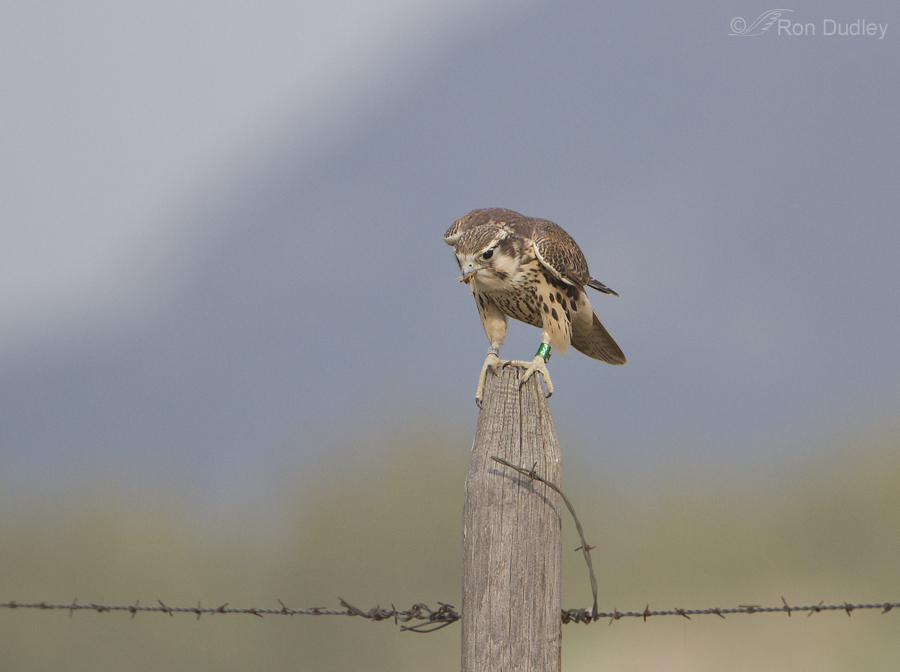
1/2500, f/5.6, ISO 640, 500 f/4, 1.4 tc, natural light, not baited, set up or called in
Three things were immediately obvious as I very slowly drove up on this bird in Montana’s Centennial Valley – it was a young juvenile, it was eating a grasshopper and it was banded. In fact it had two bands.
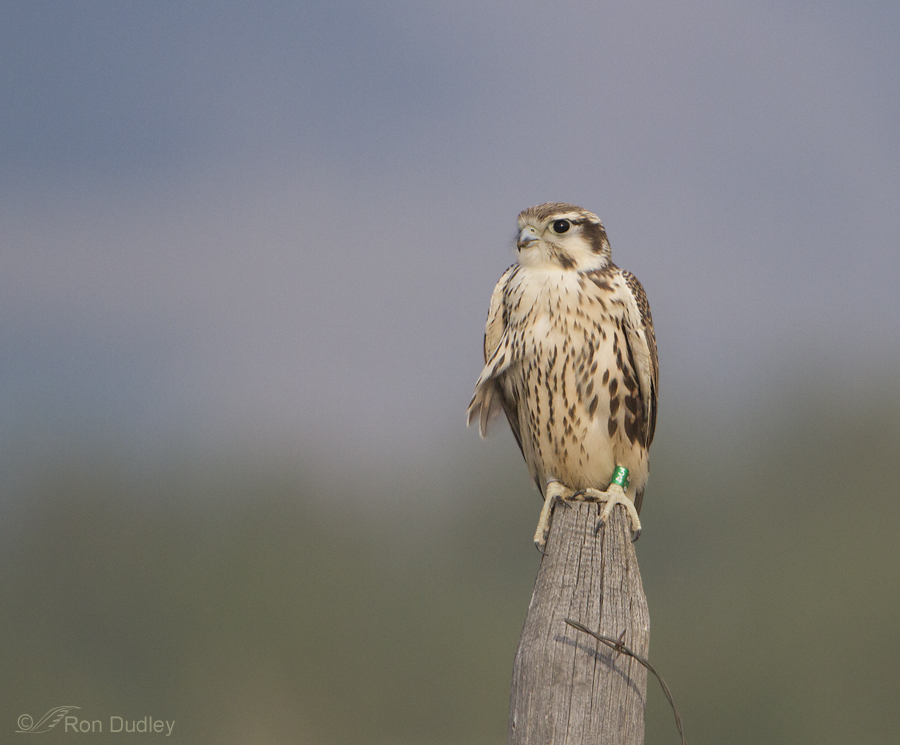
1/3200, f/5.6, ISO 800, 500 f/4, 1.4 tc, natural light, not baited, set up or called in
As I got closer it didn’t fly off as expected. It just stood there on the post with the breeze ruffling its feathers and looking quite at ease. Perhaps its slightly bulging crop contributed to its calm demeanor. At this point I also noticed that there were dried remnants of a recent meal on its bill.
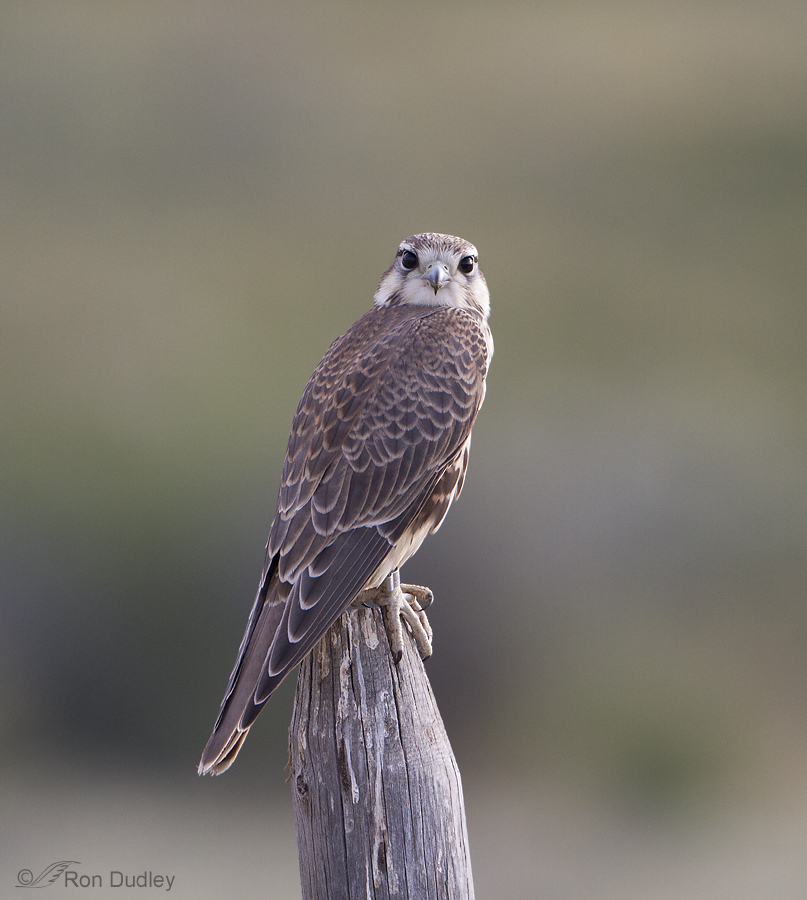
1/1600, f/4.5, ISO 800, 500 f/4, natural light, not baited, set up or called in
Soon it flew down and ate another grasshopper and then landed on a different fence post. This time it let me get even closer (as usual I was shooting from my pickup) and it was undisturbed by my presence. I was so surprised that it didn’t fly you could have, well… knocked me over with a feather. Typically prairie falcons are as skittish as any species I photograph.
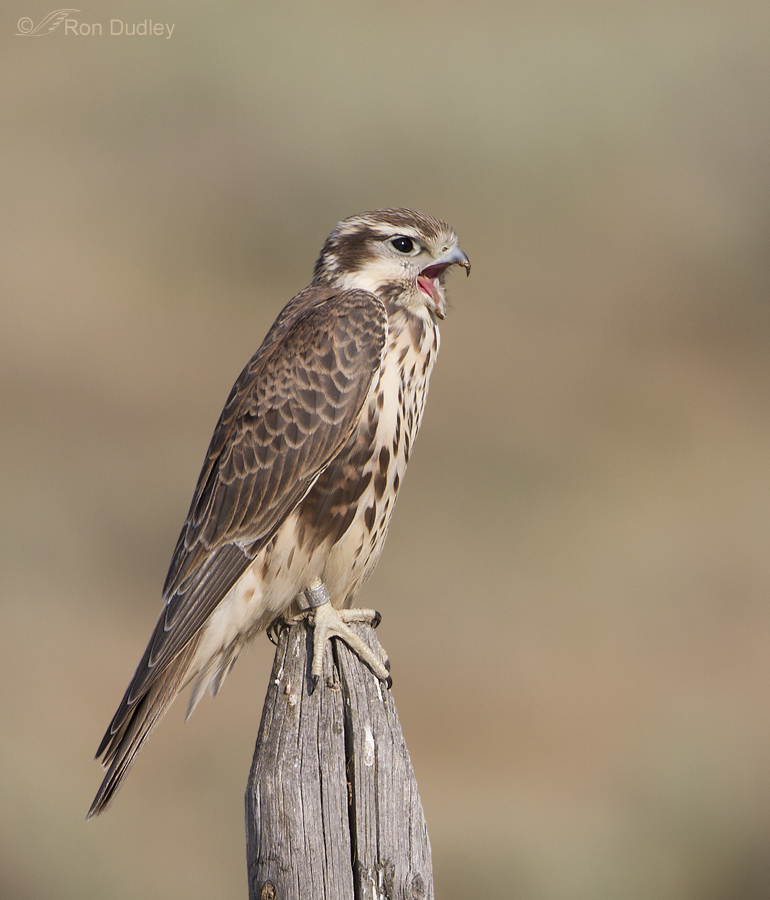
1/2000, f/6.3, ISO 400, 500 f/4, 1.4 tc, natural light, not baited, set up or called in
After hunting grasshoppers once again it landed on a third post and this time I was as close as I wanted to get. As you can see, the falcon didn’t care and was comfortable enough to yawn leisurely but enthusiastically.
My fear with being so near the falcon was that I’d clip body parts as it took off, which is exactly what eventually happened.
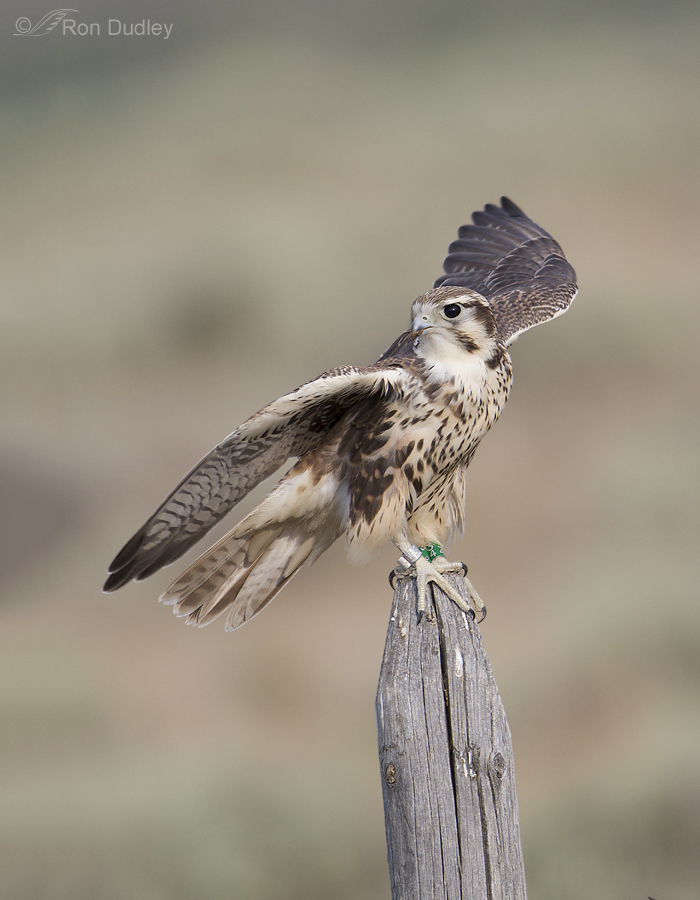
1/1250, f/6.3, ISO 400, 500 f/4, 1.4 tc, natural light, not baited, set up or called in, canvas added for composition
By this time I was near enough to the bird that I had to shoot vertically and this was the only lift off shot I got that didn’t clip its wings. As it was I had to add canvas to this image because the bird was too tight in the frame.
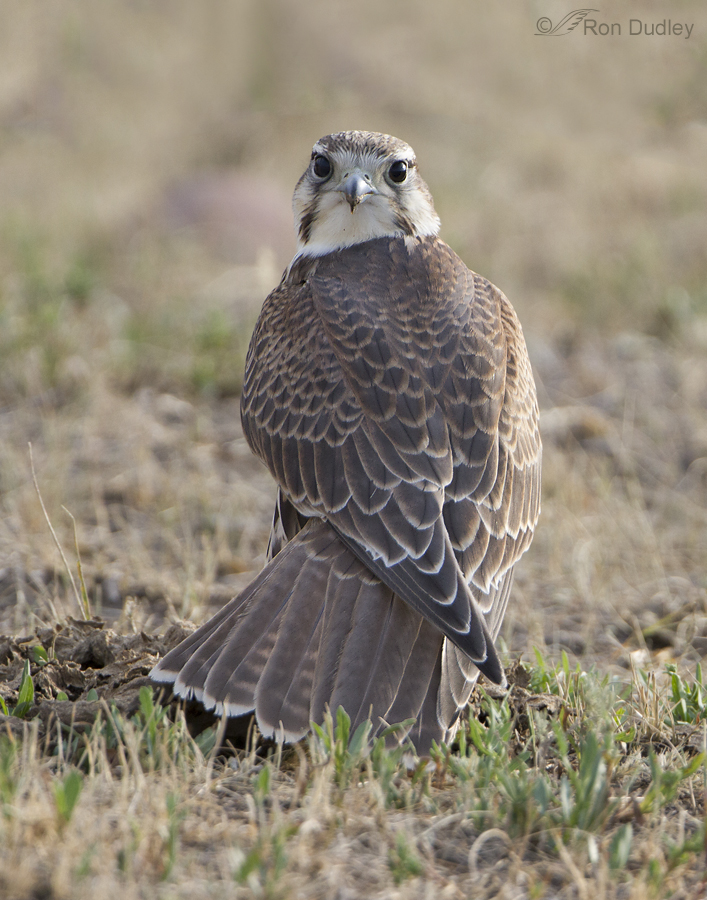
1/1250, f/5.6, ISO 640, 500 f/4, 1.4 tc, natural light, not baited, set up or called in, canvas added for composition
My consolation for the clipped shots was that the falcon landed on the ground very close to me and gave me this soulful look with a partially spread tail in what I thought was interesting side light.
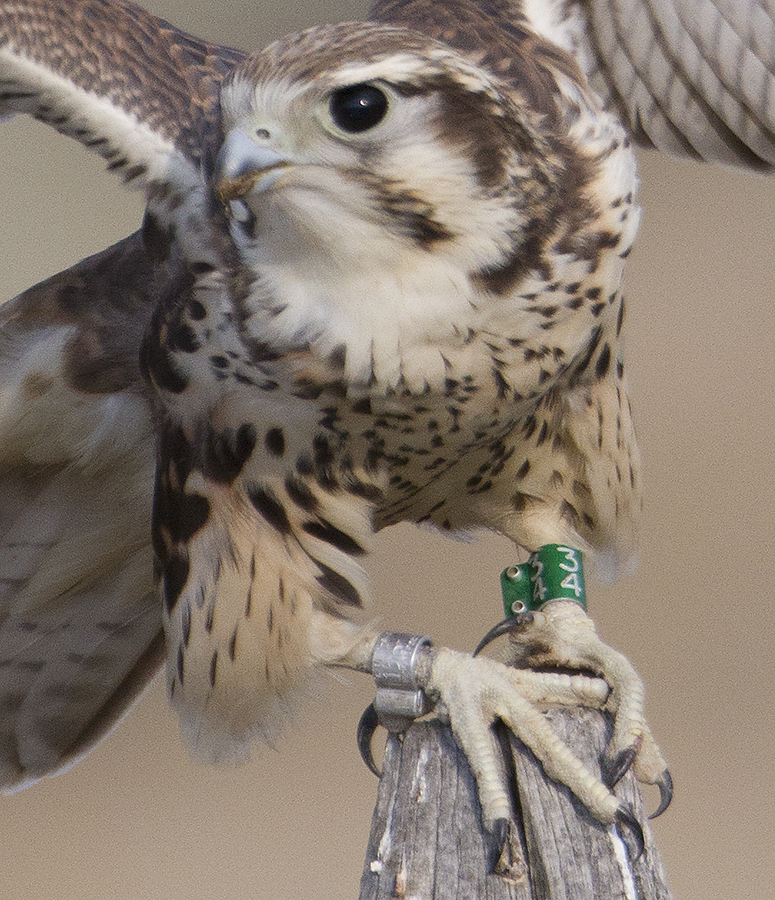
I’ll admit to being extremely curious about the origin of those two bands. I wondered if they could be falconry bands but Prairie Falcons are seldom used by falconers so my best guess was that the purpose of the bands was scientific research. I sent a couple of photos to master falconer Mark Runnels and asked him about his thoughts on the matter. He made the following observations:
- typically a wild caught Prairie Falcon used for falconry would not be banded. Federal regulations don’t require it (regulations were relaxed on this in 2009) unless it’s a sensitive species, which the Prairie Falcon is not.
- both captive bred and wild caught falconry birds that are banded have bands that look different from those on this bird (I won’t go into all the details on the differences here that Mark shared with me)
-
the bands on this bird appear to be crimped (right leg) and riveted (left leg) which would indicate that they were applied after the bird was already full size, or at least too large for a seamless band.
- Mark went into some detail about why few falconers fly Prairie Falcons but it boils down to the fact that the species is “irascible” – their personalities make them difficult to fly.
I looked through all my images of the bird to see if I could read the writing on the crimped silver band but this was the best I could do. I believe the large numbers on the crimped band are 1156 but I can’t read the rest of the writing.
My intention was to report the sighting to the Bird Banding Lab (BBL) but I was in no hurry about that because researchers typically don’t report the band numbers they’ve used until late in the season. But my curiosity insisted on immediate gratification so in the meantime I reported it to Bill West, manager of Red Rock Lakes National Wildlife Refuge (in the Centennial Valley) to see if he knew of any researcher who may have banded this falcon on or near the refuge and might be interested in documentation of the location of this young falcon.
But it was my good friend Mike Shaw of HawkWatch International who took the bull by the horns. It was Mike’s superb sleuthing that paid huge dividends when he learned that the colored band on the falcon (left foot) was issued to Doug Bell, Wildlife Program Manager for East Bay Regional Park District out of Oakland, California. Figuring that Doug might be interested in knowing that his California bird was now in the wilds of Montana, I emailed him with a link to that first blog post and an offer to supply any more information about my encounter with the bird that he’d be interested in. I also asked him if he might tell me a little about his experience with the falcon.
Doug soon responded generously with information and photos.
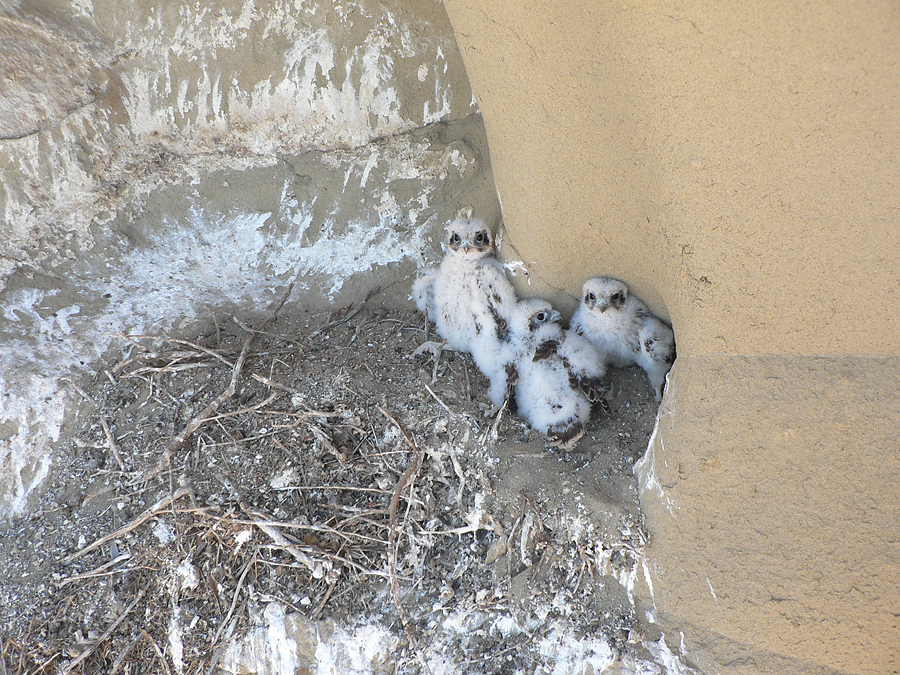
Copyright East Bay Regional Park District – used by permission
Doug and his team banded “my” Prairie Falcon (along with two other male siblings) when it was a 24 day old nestling on May 31, 2013 in the Diablo Range about 30 miles east of San Francisco. These are those three youngsters on the day of banding. Doug took the photo while hanging from a rope. He noted that these chicks were originally in a stick nest that collapsed sometime in the week before banding (you can see remnants of the nest and how steeply the cliff drops off in front of the narrow ledge). Doug expected to find that stick nest when he reached the chicks but instead they were on this narrow, rock shelf. After surviving this perilous nesting experience and a trip to Montana as such a young bird Doug referred to my bird as a “true survivor”.
- Note – since Prairie Falcons don’t construct nests (they use scrapes instead) this one must have originally been constructed by other raptors or possibly ravens
Copyright East Bay Regional Park District – used by permission
Doug took this photo of one of the adult falcons while hanging from the rope.
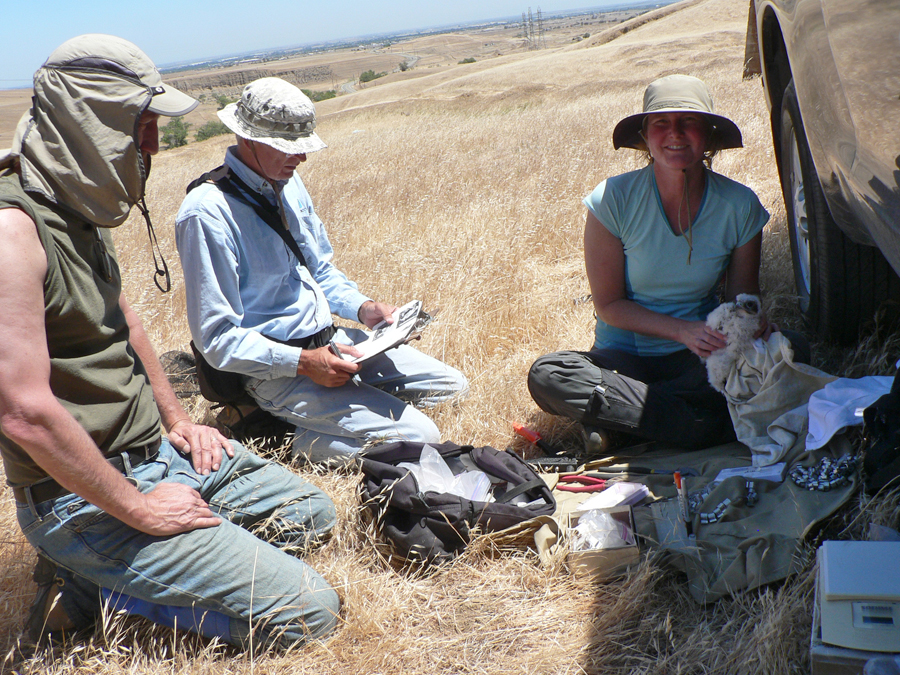
Copyright East Bay Regional Park District – used by permission
Meet the banding team (minus Doug) while they were banding the 3 chicks – (L-R) Joe DiDonato, Harvey Wilson and Erika Walther.
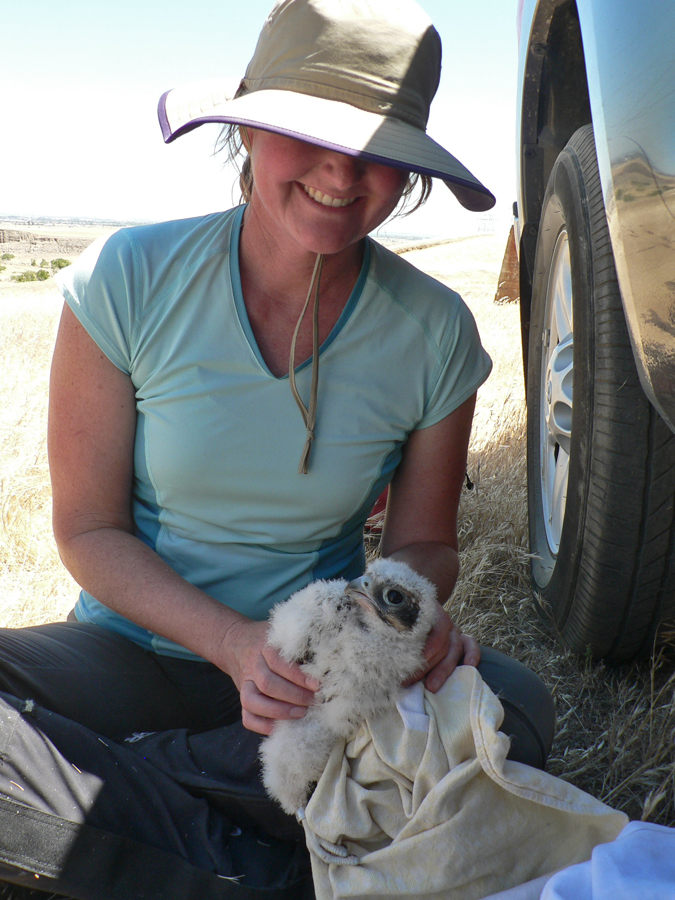
Copyright East Bay Regional Park District – used by permission
Here’s Erika with one of the three chicks. There’s a 50/50 chance that this youngster is “my” bird since only two of the chicks were banded silver on the right leg and green on the left (you can see the silver band on the right leg of this bird).
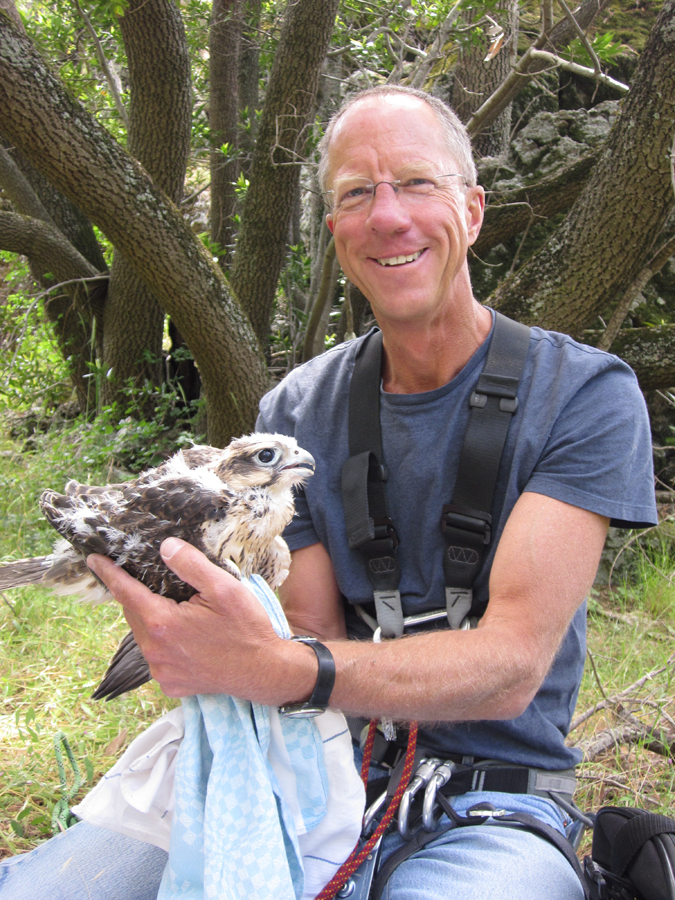
Copyright East Bay Regional Park District – used by permission
And this is Doug at a different nest site in 2011.
I enthusiastically support the work that Doug and his team are doing in support of Prairie Falcons, especially because his results are being used to promote the purchase of new habitat and open space. I’ll let him describe his work in his own words:
- “I have been studying the population genetics and biology of prairie falcons in California since 2002. I am especially interested in population sub-differentiation and how they use the landscape in regards to land management and human development. I have had two graduate students complete Master’s studies on prairie falcons and am in the process of writing those up for publication. The Park District and others have used the information from our studies to help identify and purchase some of the last best grasslands in the east SF Bay Area for open space. We are also concerned about the ongoing impacts of the Altamont Pass wind turbines on falcons and other raptors, especially golden eagles“.
Here’s a couple of other interesting tidbits:
- assuming that he fledged at about 38 days of age, my very young bird made it all the way to Montana less than 6 weeks later (and appeared to be thriving)
- team member Joe DiDonato had banded prairie nestlings in the east SF Bay area back in the 1990s and two of those nestlings ended up in Montana in their first summer as well
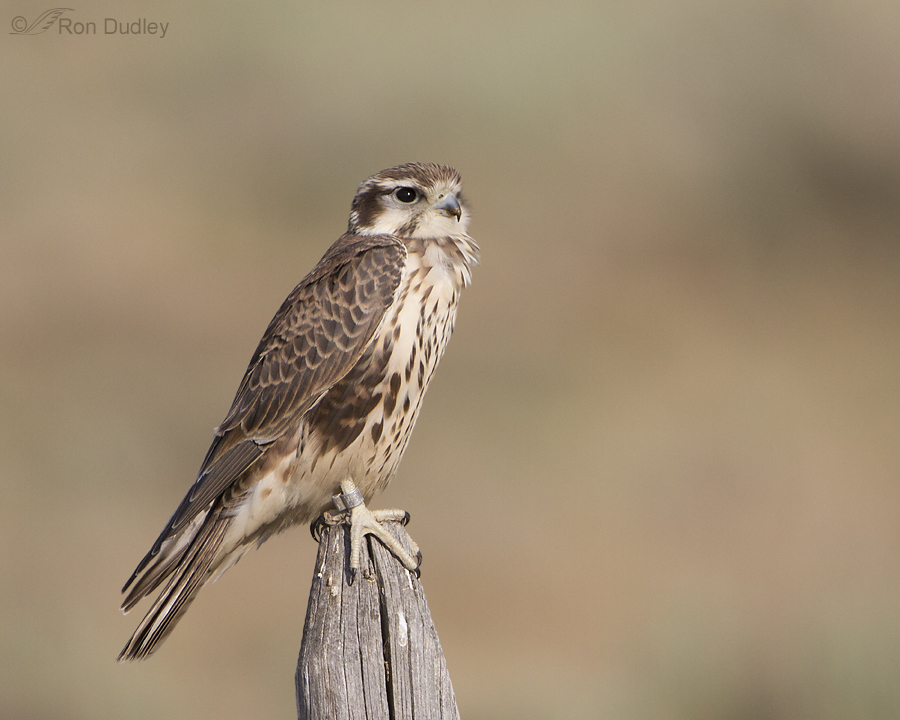
And here’s my bird in all his glory, sitting on a fence post in southwest Montana – dried food on his bill and looking for more.
Prairie Falcons are a special species for me. They’re beautiful, tough, stubborn (Mark Runnels calls them “irascible”), incredibly skilled hunters and a hugely challenging quarry for the photographer because they’re nearly always so incredibly difficult to approach. I became particularly enamored with my Montana bird when it let me get so close for so long.
And now that I know more about the history of this particular bird there’s no better way to say it. I’m infatuated.
Ron
PS – Apologies to “old-timers” who’ve already seen both posts but it’s been my intention for a long time to incorporate these two posts into one so the story flowed continually from beginning to end. The result is a long post (and lots of reading) but that seemed like the best compromise.


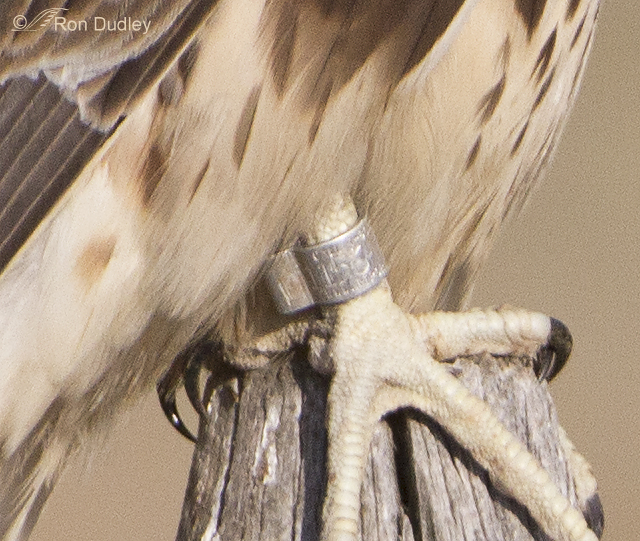
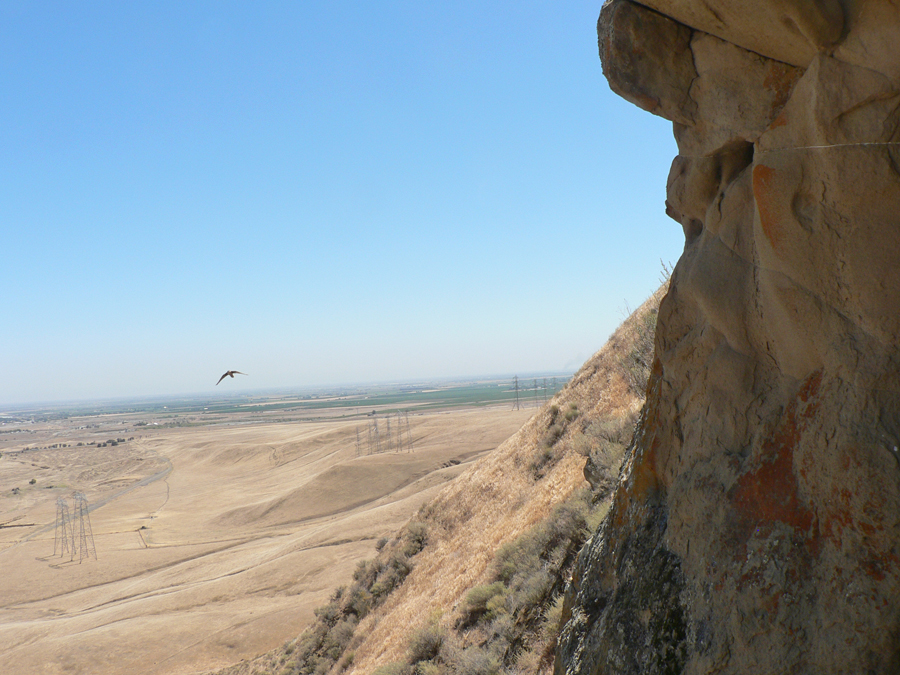
Delightful back story and perfect images. I’m always thrilled to spot a Prairie Falcon. They are rare on the coast.
These images are incredible, Ron, especially the “soulful” shot- my favorite! What a privilege to be so close to this adorable bird, especially when they are known to be skittish. I can completely see why you’re infatuated! 😊
Mt. Diablo is in my backyard!! What a fascinating story (and superb photos too!)
Thank you, Nicole.
Ron, I very much enjoyed your story – it is not too long! The photos help tell the story. I particularly like the last photo and your comment: “And, here’s my bird in all his glory”. That comment says it all. Thanks for the great post.
“That comment says it all”
Yes, it does, Alice – at least about how I feel about that bird. It’s funny how knowing about its background made that falcon so much more special for me. They’re all special but…
That is so interesting. I would never have guessed the young bird would fly to Montana. Nice to see it is ok. Thanks Ron.
Thank you, Jean.
Thank you, Ron. Your reader Dick Harlow sounds like one of our team members. We talk all the time about how purposefully blind people are. We have some motion-activated cameras along the most-poached trails and keep data on trespassers. People stop, read the signs, and walk straight past them. Young, old, fat, thin–there’s no profiling the obvious trespasser. Then, if we catch them, call them back, intercept them as they come back down, the retort is always: “Signs? What signs?” Laws are meant for someone else, apparently.
Yup, Dick’s one of the good guys…
Don’t get me started Anastasia! And if the parent birds defend their young from intruders (defend their children), they’re vicious, dangerous birds…OK, my blood pressure is rising…ARGH!
Ron, it is so much fun to read this. Thanks again for your warm-hearted generosity in granting us permission to use your PEFA sequence in our outreach. I have visions of thrilling my slide show audiences with a fast-forward through those shots. Thanks also for noting our work in Pine Canyon on the westernmost slope of Mount Diablo. We don’t actually have any authority; we’re an educational group, and hope to intercept hikers before they trespass. Once they get up into those rocks, it’s tough to do much about it–but we do call the dispatch units of the two parks involved in the closure zone in case a ranger is handy. (Not often.) Staff is short in all our parks everywhere, it seems. We volunteers have to pick up the slack. Thank you!
Anastasia (Staci), I hope your audiences enjoy your slide show and are impressed by Peregrines and their need for some protection while nesting.
Sounds like you have a tough job keeping trespassers out of the nesting area. I applaud your efforts!
As a past bander and one interested in saving falcons, congratulations on helping them them out. We have seen a definite increase, slow but an increase just the same, over the years in Peregrines nesting success in Vermont since DDT and “Silent Spring”. No matter how many signs are put up or the necessary verbiage both written and on posters about leaving nesting falcons alone, there just seems to be purposeful ignorance or the sign is for the other guy not me type of attitude around nesting sites. Consequent’y it has been tough to find individuals who will spend a nesting season protecting these nesting falcon sites from hikers and others. I certainly hope they are successful.
I hope they are too, Dick. Thanks.
Colour me awed, amazed and delighted.
Too long? I would happily have read and viewed this story at twice the length.
Then you have more patience than many, EC. Thanks for the vote of confidence.
No Ron, EC’s right! I’d have happily kept reading for a long, LONG time!
You are seriously outnumbered Ron.
Fantastic post. I enjoy your posts and all the comments as well. Great way to start or continue a day depending when I get the chance to log on. Keep up the great work.
Thank you, Betty.
Ron,
Thanks for the background and story. Again you show your flair for writing even with mostly documentary material. Great shots. I continue to try and improve my own photography. Keep up the blog. I enjoy it every day.
Stephen Clayson
“you show your flair for writing even with mostly documentary material”
That means a lot, Stephen. Thank you.
I amused myself by thinking those three PF’s got banded in CA and thought, “To heck with this! I’m heading for the wide, open spaces…”
🙂
And yet another splendid start to my day (I’m sick, so my day is starting late, despite Zoe’s no-snooze-button alarm protests–Zoe is the JRT.). You know you’ve got me with raptors, but this was an especially delightful read while gawking at the photos. I’m continually gobsmacked with the sheer beauty of these birds, which pegs the take-your-breath-away meter.
I’ve often heard that prairies are, well, irascible might be a little strong, but certainly stubborn and cranky could describe them. But I think that’s more about humans trying to be their boss, and that just ain’t gonna happen. Falconers really need to get over that top-of-the-food-chain concept!
From what little I know, they could also be called the redtail of the longwing group. They’re not fussy about whether their prey has feathers, fur or scales. If it’s food, they’ll catch it and eat it. For example, they can and will catch/eat jackrabbits, making repeated stoops until the jack stops running and acquiesces to the invitation to join them for dinner! They’re pretty darn fierce raptors!
Again, just thank you!
” making repeated stoops until the jack stops running and acquiesces to the invitation to join them for dinner”
Love the way you said that, Laura! Thank you.
Well I’ll be damned. Many years ago I was on the East Bay Regional Parks District Citizens’ Advisory Council, and photographed these cliffs and falcons regularly. Great to read all this!
It’s a small world, Martha!
Stories of people like all of those dedicated volunteers are thrilling and encouraging and worthwhile reading ( when so much of the “news” is not )– thank you for promulgating them !
There’s lots of good folks out there, Kris. It’s just that these days the stinkers get most of the attention.
Thnks for the wonderful post. Enjoyed all the info and the photos. Great story.
Thank you, Bill.
Incredible shots!!! In the photo of the cliff, taken while dangling on a rope (a bird off in the distance), there’s a patch of lichens on the rock wall that looks like a flying bird of prey…(I’m just curious, but why do I almost always like the faces of naturalists???) the few pompous ones leave me as cold as a polar bear’s butt, but the others …..
Your observation about naturalists made me smile, Patty. Good eye to spot the shape of that lichen patch.
Lovely pictures!
Every time I see a bird with bands I wonder about the justification for the almost-certain degradation in quality/length of that individual’s life. It used to be that understanding bird migration was one of the main justifications for banding. Now, however, ebird provides a vastly bigger dataset with no cost to individual birds. Is it time to stop banding?
Brad, I have some of the same concerns you do about some of the banding that’s done and have had for a long time. Too much of it is done largely because it’s “sexy” or because (for example) grad students and doctoral candidates “need” it on their resume.
But in this case, largely because Doug’s work helps to promote additional habitat and open space, I support it (for what that’s worth…).
Congratulations Ron on your photos being used by Staci and her team helping protect the Peregrines out there! That is a smart move and of course a great cause. I enjoyed your story on the Diablo Range Prairie Falcons when I first read it, and again just now. It is great when things like this happen and we learn a little more about migration patterns. I have been helping Peregrine researchers here in New Mexico for years and we get to see the same mated pairs return every year, and yet have no idea where they migrate to in the winter.
Keeping people away from cliffs during nesting season is so important. Surprisingly, at least from my experiences, the rock climbers have all been pretty good in respecting the closures put in place (in Yosemite, and other popular climbing areas). I think the network of climbers does a pretty good job of self policing that. A few times we have had to ask the USFWS to reinforce closures with more signage, or contacting climbers directly. All in all the climbing community has been very respectful of the nesting falcons.
One eyrie we monitor has failed year after year. Remote cameras are setup on it to find out why. We suspect it is Great Horned Owls, but not 100% sure. The chicks fall from the nest, 300 feet to the ground, right before they start learning to flap their wings. One year I was asked to retrieve one chick that survived the fall. The authorities chose to try and rehab the near fledgling. Amazingly, he was trained to hunt in captivity by a respected falconer. That is impressive training, considering how Peregrines hunt in the air, on flying birds. The young falcon was finally released at the Bosque del Apache NWR. We think we see him every now and then since there is one wild falcon there, with some bands on it, who is clumsy when he stoops on a bird. The result is usually a crash of both birds into the brush or ponds. Seeing what we think is the rescued falcon, now as adult surviving in the wild always brings a warm smile to me.
“the rock climbers have all been pretty good in respecting the closures put in place”
That’s excellent news, Ed. I only wish that bird photographers had a record that good. Kudos to the rock climbers!
I enjoyed your story about the eyrie you monitor. And I fully understand the connection you feel with that Bosque bird. As you know it’s a very special feeling…
Are the numbers on the two silver bands the same? If not, does Doug know the number of the band on the chick Erika is holding? I was thinking the sequence of the banding was documented and he may know if the chick in the picture was the first one or second one banded. Just trying to find a way to verify if the chick Erika is holding is “your” chick or not. Loved the story and photos! Thank you for the journey! (Sybby)
Apparently there’s no way to know, Sybil. It was Doug in his email to me who mentioned the “50/50” chance and explained why. If Doug doesn’t know, no one does.
Interesting! And never boring. Every once in a while we are privy to a [1/2500, f/5.6, ISO 640, personal experience in nature and it seems you have your share. Your time spent in the field and your expertise gives you these opportunities so you can share with us. Thank you, Ron.
You’re right, Judy. Experiences somewhat similar to this are few and far between but the more time you spend in the field the more likely they are to occur. Thank you.
Is it unusual for a Prairie Falcon to travel from San Fran to Montana?
No, it isn’t, Ann. As I said in my post Joe DiDonato documented two other Prairie Falcons fledged in that area that ended up in Montana the same summer they were fledged.
Wow, what an incredible story of this young survivor! I’m so glad you were able to find Doug and get the photos and details of its banding. Your photos of it are beautiful!
Thanks very much, Charlotte. I’m glad you enjoyed the story – it’s likely too long for some folks but I thought I had to include everything relevant.
Absolutely wonderful series of photos and story, Ron! 🙂 Makes my day! On a different note the “blue screen” was a result of Symantec and Microsoft having conflicts on their last update – sharp cousin found the info on the web. Down side is it’s basically like starting with a new computer……:(
Thanks, Judy. I know of one other person that got that blue screen of death in the last few days. It’s always traumatic and often expensive…
Wow! Wonderful shots and an interesting story How fortunate we are to have folks like a f you who care and do such good wor!
Charlotte
Thanks very much, Charlotte. I’m glad you enjoyed the story – it’s likely too long for some folks but I thought I had to include everything relevant.